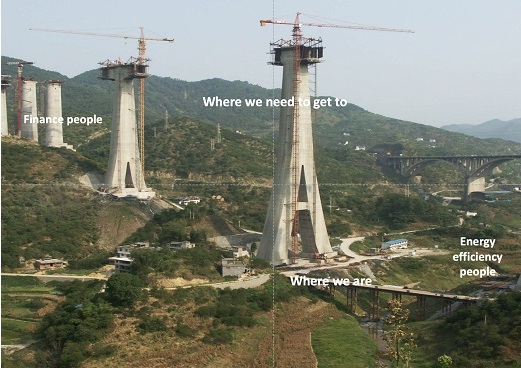Monday 22 February 2021
Over the last few years, the idea of energy efficiency as infrastructure has gained traction, and it is good to see the continued emphasis on improving the efficiency of the building stock in the work of the National Infrastructure Commission. Its recent Annual Monitoring Report 2021 noted:
‘Across all its policies and programmes, government must now ensure action is being delivered on the ground and the energy efficiency of the building stock is increasing at the necessary rate.’ We seem a long way from reaching that necessary rate.
The government is establishing a National Infrastructure Bank ‘to catalyse private sector investment’ into infrastructure with three priorities: net zero; levelling up; and covid recovery. It seems to be on-track for having it launched by the summer. This is a positive development as long as it focuses on the real problem around energy efficiency – the development gap between what we know is huge potential and bankable projects. We know that institutional investors would like to invest in more energy efficiency and net zero projects, the problem is finding bankable projects at scale and that comes down to a lack of capacity to develop projects, a lack of capacity in the demand side, the supply side and in the financial industry.
In energy efficiency at least the National Infrastructure Bank need to focus attention on bridging that development gap, and that means taking equity type risk and/or using some kind of guaranteed debt to fund development work. It also means actively building development capacity and not just being passive and awaiting projects to appear. In related work we are doing around the world we talk about ‘transaction enablers’ – ways of increasing the flow of project development – and ‘risk mitigators’, ways of reducing the risks at least in the early stages. Both are needed. When the Green Investment Bank was established it promised a lot on energy efficiency but a failure to address the development gap meant much of the effort labelled as energy efficiency ended up not really being efficiency. It took a passive approach to the development gap, hoping that demand would appear.
The National Infrastructure Bank needs to be much more active, and focused on bridging the development gap with specially designed financial instruments and capacity building programmes. If it can do that it will catalyse private sector investment from the institutional funds looking to invest in energy efficiency at scale.

Comments
There is 1 comment on “A message for the National Infrastructure Bank – focus on the development gap”:
Dr Steven Fawkes
Welcome to my blog on energy efficiency and energy efficiency financing. The first question people ask is why my blog is called 'only eleven percent' - the answer is here. I look forward to engaging with you!
Email notifications
Receive an email every time something new is posted on the blog
Tag cloud
Black & Veatch Building technologies Caludie Haignere China Climate co-benefits David Cameron E.On EDF EDF Pulse awards Emissions Energy Energy Bill Energy Efficiency Energy Efficiency Mission energy security Environment Europe FERC Finance Fusion Government Henri Proglio innovation Innovation Gateway investment in energy Investor Confidence Project Investors Jevons paradox M&V Management net zero new technology NorthWestern Energy Stakeholders Nuclear Prime Minister RBS renewables Research survey Technology uk energy policy US USA Wind farmsMy latest entries



“Across all its policies and programmes, government must now ensure action is being delivered on the ground and the energy efficiency of the building stock is increasing at the necessary rate.’ ”
WHY?
“We seem a long way from reaching that necessary rate.”
WHAT IS THAT “NECESSARY RATE”? CAN ANYONE DEFINE IT?
“the development gap between what we know is huge potential and bankable projects.”
HOW DO WE KNOW THERE IS “HUGE POTENTIAL”?
OUR TYPICAL PROJECTS HAVE 50 TO 500 YEAR PAYBACKS FROM AN ENERGY SAVINGS PERSPECTIVE. RECENTLY, EVEN MATT GOLDEN HAS ADMITTED THAT AIR SEALING (THE MOST IMPACTFUL IMPROVEMENT NEXT TO LIGHT BULBS) DON’T SHOW SAVINGS JUSTIFICATION.
SO I’M WONDERING HOW UNSUPPORTED HYPERBOLIC CLAIMS ABOUT THE VALUE OF ENERGY EFFICIENCY DON’T REPRESENT A BIG PART OF THE PROBLEM RATHER THAN PART OF THE SOLUTION.